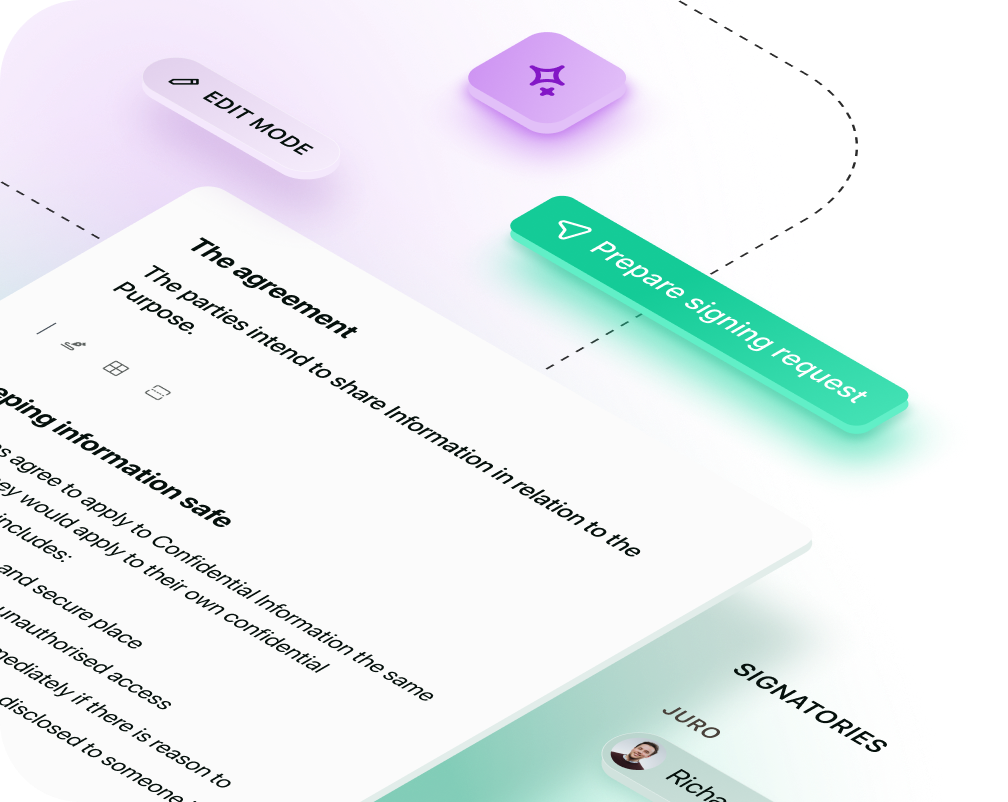Solutions
Customer Support
Resources
Download your free product supply agreement template and streamline your contract creation process.




Whether you’re involved in a complex supply chain, managing international orders, or starting a new supplier relationship, a well-drafted product supply agreement sets the stage for a smooth collaboration and clear expectations for both parties.
In this guide, we'll cover everything you need to know about these agreements, including their purpose, key components, and how to manage them effectively.
A product supply agreement is a legally binding contract between a supplier and a buyer that outlines the terms and conditions for the supply of products. This document serves as the foundation of the supplier-buyer relationship, ensuring both parties understand their roles, responsibilities, and expectations.
A product supply agreement is a legally binding contract between a supplier and a purchaser outlining the terms and conditions for the supply of products. Its primary purposes are the following:

Product supply agreements are typically managed by multiple stakeholders within an organization, each playing a distinct role in ensuring the agreement's effectiveness and compliance.
Legal departments are responsible for drafting and reviewing product supply agreements to ensure they meet legal standards and protect the company’s interests. They also handle any legal disputes that may arise from the agreements.
Procurement professionals oversee the negotiation of terms, ensuring the agreement aligns with the company’s supply needs and budget constraints. They are also responsible for maintaining relationships with suppliers and managing the supply chain.
Sales teams work closely with procurement to ensure that the supply agreements align with sales forecasts and customer demand. They also negotiate terms that can impact pricing and delivery schedules.
Operations teams ensure that the delivery schedules and product specifications outlined in the agreement are feasible and align with the company’s operational capabilities. They also manage the logistics of receiving and handling supplied products.
By collaborating effectively, these teams ensure that product supply agreements are comprehensive, enforceable, and beneficial to the organization.
.png)
Product supply agreements are utilized in various business scenarios to establish clear and reliable supply arrangements. Some common use cases include:
New supplier relationships: When a company begins working with a new supplier, a product supply agreement establishes the terms and conditions of the partnership, setting a solid foundation for future transactions.
Long-term supply arrangements: For ongoing relationships where products are supplied regularly, these agreements help maintain consistency and reliability, ensuring that both parties adhere to agreed-upon terms over an extended period.
Complex supply chains: In industries with intricate supply chains, product supply agreements ensure that all parties involved are aligned on terms and conditions, facilitating smooth coordination and minimizing disruptions.
International trade: When products are sourced from international suppliers, these agreements address cross-border issues such as customs, tariffs, and international payment methods, ensuring compliance with international trade regulations.
By using product supply agreements in these scenarios, businesses can manage their supply relationships more effectively, reducing risks and improving operational efficiency.

A comprehensive product supply agreement template should include the following elements to ensure clarity and enforceability:
Parties involved: Names and details of the supplier and buyer, including contact information and legal addresses.
Product description: Detailed specifications of the products being supplied, including quality standards, quantities, and any special requirements.
Pricing and payment terms: Agreed prices for the products, payment schedule, and accepted payment methods. This section should also address any discounts, penalties for late payments, and procedures for handling price adjustments.
Delivery terms: Detailed delivery schedule, shipping method, responsibilities for shipping costs, and procedures for handling delays or incomplete deliveries.
Quality standards: Criteria for product quality, inspection procedures, and processes for handling defective goods, including returns and replacements.
Confidentiality: Terms for protecting confidential information shared between the parties, including restrictions on disclosure and use of proprietary information.
Warranties and liabilities: Warranties provided by the supplier regarding product quality and performance, as well as limitations on liability and indemnity clauses.
Dispute resolution: Mechanisms for resolving disputes, including mediation, arbitration, or litigation, and the jurisdiction under which disputes will be resolved.
Termination conditions: Conditions under which the agreement can be terminated by either party, including notice periods and procedures for handling breaches of contract.
Compliance: Requirements for compliance with relevant laws and regulations, including environmental, labor, and safety standards.
By including these elements, a product supply agreement template provides a comprehensive framework that can be customized to meet the specific needs of each supply relationship.

The manual approach to managing product supply agreements can be inefficient and risky. Here’s are some of the challenges involved:
Fortunately, Juro can transform how you manage product supply agreements by providing a streamlined, automated solution. Here's how:
Automated drafting and reviewing: Juro's AI-powered contract management platform speeds up the drafting and reviewing process, reducing errors and eliminating the need for repetitive back-and-forth between departments.

Version control: Juro maintains a single, centralized version of each contract, ensuring all stakeholders are working with the most up-to-date document. This eliminates confusion and inconsistencies.
Efficient approval process: Juro automates the approval workflow, routing agreements through the necessary departments quickly and efficiently. This reduces bottlenecks and speeds up the supply process.

Secure storage and easy retrieval: Juro stores all contracts in a secure, centralized digital repository, making retrieval fast and easy. This minimizes the risk of misplaced or lost documents.
Juro’s AI-native contract automation platform empowers all teams to create, agree, execute and manage contracts up to 10x faster than traditional tools. To find out more, hit the button below to book your personalized demo.
Juro is the #1-rated contract platform globally for speed of implementation.


Juro embeds contracting in the tools business teams use every day, so they can agree and manage contracts end-to-end - while legal stays in control.
Book your demo